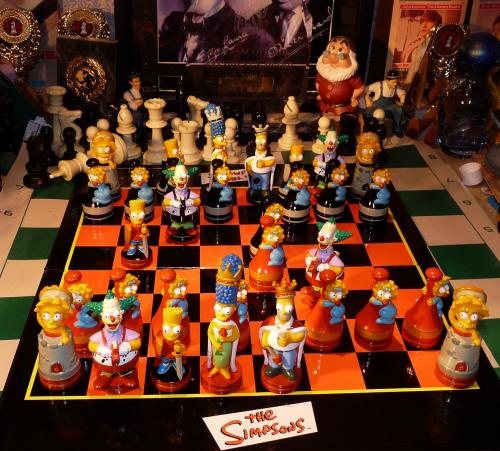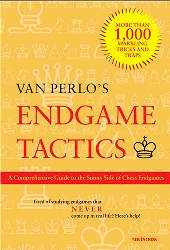Picked up one of these for £2.00 at a Charity Shop.

A Simpson Chess Set, it’s hideous, I hate novelty chess sets.
I’ll wrap it up and give it to my son-in-law for Christmas.
He hates Chess and he hates the Simpsons.
(he hates the Simpson’s because he looks like and gets called Ned Flanders.)


There is no way anyone could cover all the intricacies of Rook Endings in a weekend blog.
All I can do is drop you tit-bits to whet you appetite. The rest is up to you.
There are some excellent books on the endgame out there that will reap more
benefits and points than 100 books on the opening.
I'm still reading this:

Which lit a fire in me regarding endings, especially Rook Endings.
It does however require you to know the basics.
I went through (skimmed is a better word for me) Keres Practical Endgames.
It served as a good foundation but the gaps in my endgame play are my fault.
I decided along time ago to fight my battles in the opening and middle game
and only go into an ending if it was a clear win.
When a dreaded Rook endgame appears it really is a different game.
I envy those can go into a Rook ending full of confidence and only now I can
appreciate the effort these guys must have put in.
Having said that….
(For God’s sake greenpawn cut the prattle and show us something………….Russ).
So why did I show this elementary win.? Because it is not what happened,
Black set White a ‘rule of thumb’ trap and White fell for it.
And I invented my own wee trap in the analysis!.
(well not really, the trap is probably 500 years old but I spotted it coming without
any prompting. Once I start spotting these traps a long way off I know I’m getting better.)

I work beside a chess player. Findlay Murray.
He is actually a RHP member (but I won’t reveal his nik)
He recently played in the Scottish National League and gave me
a couple of his games to look at. One fits this blog’s current theme perfectly.

Further examples of how these blogs are put together.
I recalled the bones of this position from an old puzzle book.
I dug it out and put on the unremembered flesh. (names, date and exact position).
A nice simple thinker to get your brain cells warmed up. (solution below).
So off into the RHP DB looking for two split pawns on the 7th rank
to see if anyone on here has played something similar.
It’s a trick I often use to unearth games.
Find a known combination played by GM’s, look for a corresponding pattern
and see how you guys have managed to screw it up. 🙂
Using this method I’ve uncovered some brilliant masterpieces of ingenuity.
Ingenious in the fact that it often looks harder to lose from a position than it is to win it.
You guys find some truly awesome ways to lose a game of chess.
I found hundreds of White wins with split pawns on the seventh.
But sticking out like a black eye on the face of a choir boy was this ‘0-1’
“Most likely a time-out.” I thought to myself. But I looked anyway.

The deviousness of White’s play here has to be applauded.


I showed the original position and the idea to Murray.
He agreed it was good, so I suggested we play it out. I took Black.
And just before he played 5.Rg8 he spotted the Stalemate Trick. Good.
(That's what happens if you hang around me for too long...You Check All Checks.)
The thread accompanying this blog is Thread 156720

A Simpson Chess Set, it’s hideous, I hate novelty chess sets.
I’ll wrap it up and give it to my son-in-law for Christmas.
He hates Chess and he hates the Simpsons.
(he hates the Simpson’s because he looks like and gets called Ned Flanders.)


There is no way anyone could cover all the intricacies of Rook Endings in a weekend blog.
All I can do is drop you tit-bits to whet you appetite. The rest is up to you.
There are some excellent books on the endgame out there that will reap more
benefits and points than 100 books on the opening.
I'm still reading this:

Which lit a fire in me regarding endings, especially Rook Endings.
It does however require you to know the basics.
I went through (skimmed is a better word for me) Keres Practical Endgames.
It served as a good foundation but the gaps in my endgame play are my fault.
I decided along time ago to fight my battles in the opening and middle game
and only go into an ending if it was a clear win.
When a dreaded Rook endgame appears it really is a different game.
I envy those can go into a Rook ending full of confidence and only now I can
appreciate the effort these guys must have put in.
Having said that….
(For God’s sake greenpawn cut the prattle and show us something………….Russ).
invigorate - passo RHP 2011
White can win this quite easily.
White can win this quite easily.
So why did I show this elementary win.? Because it is not what happened,
Black set White a ‘rule of thumb’ trap and White fell for it.
And I invented my own wee trap in the analysis!.
(well not really, the trap is probably 500 years old but I spotted it coming without
any prompting. Once I start spotting these traps a long way off I know I’m getting better.)
This is what happened in the invigorate - passo.
The wee Sneaky Pete I mentioned in the above game.
The Kings facing each other pattern that appeared in the above game fragment.
Is worth storing, especially if you can see it coming 8 or 9 moves ahead.
This pattern forms the blocks of a lot of Rook Ending traps and pitfalls.
This pattern forms the blocks of a lot of Rook Ending traps and pitfalls.

I work beside a chess player. Findlay Murray.
He is actually a RHP member (but I won’t reveal his nik)
He recently played in the Scottish National League and gave me
a couple of his games to look at. One fits this blog’s current theme perfectly.
F. Murray - C. Mcintee. SNCL 2013 (White to play)
Look at the position for a while so all the wee point seep in.
Note the Black King cannot stroll onto the g-file because of Rg8+ and a8=Q.
White won this by moving his King towards the Rook and playing g4.
This opened up the Kingside and with no pawns to hide behind the threat
of White giving a check and promoting on a8 forced Black’s resignation.
Is there another winning method, a slick winning method?
Note the Black King cannot stroll onto the g-file because of Rg8+ and a8=Q.
White won this by moving his King towards the Rook and playing g4.
This opened up the Kingside and with no pawns to hide behind the threat
of White giving a check and promoting on a8 forced Black’s resignation.
Is there another winning method, a slick winning method?
How about moving the White King to h2 and then playing Ra8-g8 threatening a8=Q.
When the Black Rook takes on a7 (which is forced) White can play g3 checkmate.
When the Black Rook takes on a7 (which is forced) White can play g3 checkmate.
I like nifty swift click finishes, it proves you are alert.

Further examples of how these blogs are put together.
I recalled the bones of this position from an old puzzle book.
I dug it out and put on the unremembered flesh. (names, date and exact position).
Bukic - Marovic, Yugoslavia 1968 (White to play and win.)
A nice simple thinker to get your brain cells warmed up. (solution below).
So off into the RHP DB looking for two split pawns on the 7th rank
to see if anyone on here has played something similar.
It’s a trick I often use to unearth games.
Find a known combination played by GM’s, look for a corresponding pattern
and see how you guys have managed to screw it up. 🙂
Using this method I’ve uncovered some brilliant masterpieces of ingenuity.
Ingenious in the fact that it often looks harder to lose from a position than it is to win it.
You guys find some truly awesome ways to lose a game of chess.
I found hundreds of White wins with split pawns on the seventh.
But sticking out like a black eye on the face of a choir boy was this ‘0-1’
“Most likely a time-out.” I thought to myself. But I looked anyway.
jaluh - HiChief RHP 2011
Position after Black’s 35th move Rh8-c8.
White lost this. So be warned, nothing in Chess is certain.

The deviousness of White’s play here has to be applauded.
Ravello - kwast RHP.2005

Top Hat - gbjames RHP 2008
This is a good game for the theme of this blog.
Pawn weakness’ inflicted on Black in the opening start to count in the ending.
The Rook ending hides a few instructive shots and we get a nice calculated finish.
This is a good game for the theme of this blog.
Pawn weakness’ inflicted on Black in the opening start to count in the ending.
The Rook ending hides a few instructive shots and we get a nice calculated finish.
I wanted to show this line from the above game.

Solution to: Bukic - Marovic, Yugoslavia 1968
OK. Own up. How many did I catch with the F. Murray - C. Mcintee game and the 'nifty swift click finish’
I showed the original position and the idea to Murray.
He agreed it was good, so I suggested we play it out. I took Black.
And just before he played 5.Rg8 he spotted the Stalemate Trick. Good.
(That's what happens if you hang around me for too long...You Check All Checks.)
The thread accompanying this blog is Thread 156720

